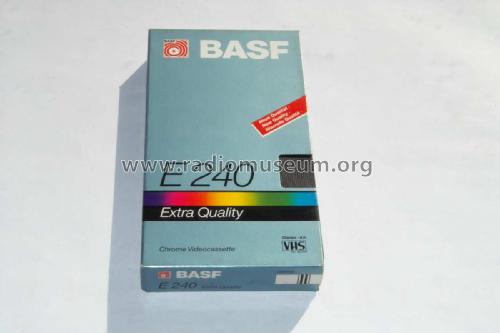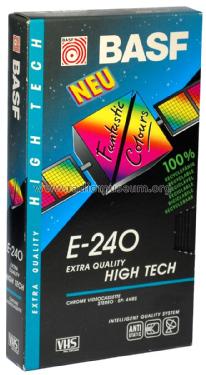VHS Video Cassette alle
BASF, Badische Anilin- & Soda-Fabrik, EMTEC; Ludwigshafen
- País
- Alemania
- Fabricante / Marca
- BASF, Badische Anilin- & Soda-Fabrik, EMTEC; Ludwigshafen
- Año
- 1977 ?
- Categoría
- Miscelanea, objetos de propaganda, pines, banderines, ceniceros, otros, etc.
- Radiomuseum.org ID
- 280396
- Gama de ondas
- - no hay
- Especialidades
- Special Tape or Cassette-Format
- Tensión de funcionamiento
- No necesita alimentación
- Altavoz
- - - No hay salida de sonido.
- Material
- Plástico moderno (Nunca bakelita o catalina)
- de Radiomuseum.org
- Modelo: VHS Video Cassette [alle] - BASF, Badische Anilin- & Soda-
- Forma
- Formas varias descritas en notas aparte.
- Ancho, altura, profundidad
- 190 x 28 x 104 mm / 7.5 x 1.1 x 4.1 inch
- Anotaciones
-
This page is for all BASF labeled VHS type Video Cassette tapes for all TV standards.
Please do not modify this page.
Load only pictures with all data in the picture legend!
Bitte nur Bilder hochladen, alle Informationen/Daten in die Bildlegende.
Taken from wikipedia:Cassette and tape design
The VHS cassette is a 187 mm wide, 103 mm deep, 25 mm thick (7 3⁄8 × 4 1⁄16 × 1 inch) plastic shell held together with five Phillips head screws. The flip-up cover that protects the tape has a built-in latch with a push-in toggle on the right side (bottom view image). The VHS cassette also includes an anti-despooling mechanism consisting of several plastic parts between the plastic spools, near the front of the tape (white and black in the top view). The spool latches are released by a push-in lever within a 6.35 mm (¼ inch) hole accessed from the bottom of the cassette, 19 mm (¾ inch) inwards from the edge label.
There is a clear tape leader at both ends of the tape to provide an optical auto-stop for the VCR transport mechanism. A light source is inserted into the cassette through the circular hole in the center of the underside when loaded in the VCR, and two photodiodes are located to the left and right sides of where the tape exits the cassette. When the clear tape reaches one of these, enough light will pass through the tape to the photodiode to trigger the stop function; in more sophisticated machines it will start rewinding the cassette when the trailing end is detected. Early VCRs used an incandescent bulb as the light source, which regularly failed and caused the VCR to erroneously think that a cassette is loaded when empty, or would detect the blown bulb and stop functioning completely. Later designs use an infrared LED which had a much longer lifetime.
The recording media is a 12.7 mm (½ inch) wide, approximately 800 foot long Oxide-coated Mylar magnetic tape that is wound between two spools, allowing it to be slowly passed over the various playback and recording heads of the video cassette recorder. The tape speed for "Standard Play" mode (see below) is 3.335 cm/s (1.313 ips) for NTSC, 2.339 cm/s (0.921 ips) for PAL—or just over 2.0 and 1.4 metres (6 ft 6.7 in and 4 ft 7.2 in) per minute respectively.Tape lengths
Both NTSC and PAL/SECAM VHS cassettes are physically identical (although the signals recorded on the tape are incompatible). However, as tape speeds differ between NTSC and PAL/SECAM, the playing time for any given cassette will vary accordingly between the systems. In order to avoid confusion, manufacturers indicate the playing time in minutes that can be expected for the market the tape is sold in. It is perfectly possible to record and play back a blank T-XXX tape in a PAL machine or a blank E-XXX tape in an NTSC machine, but the resulting playing time will be different from that indicated.
To calculate the playing time for a T-XXX tape in a PAL machine, use this formula: PAL/SECAM Recording Time = T-XXX in minutes * (1.426)
To calculate the playing time for an E-XXX tape in an NTSC machine, use this formula: NTSC Recording Time = E-XXX in minutes * (0.701)
Some new Panasonic NTSC/ATSC recorders also include a XP mode which is not part of the official specification. It enables recordings at double the SP speed, such that a T-180 holds 1.5 hours.
E-XXX indicates playing time in minutes for PAL or SECAM in SP and LP speeds.
T-XXX indicates playing time in minutes for NTSC or PAL-M in SP, LP, and EP/SLP speeds.
SP is Standard Play, LP is Long Play (½ speed, equal to recording time in DVHS "HS" mode), EP/SLP is extended/super long play (⅓ speed) which was primarily released into the NTSC market.
- Peso neto
- 0.240 kg / 0 lb 8.5 oz (0.529 lb)
- Autor
- Modelo creado por Reinhard Keins. Ver en "Modificar Ficha" los participantes posteriores.
- Otros modelos
-
Donde encontrará 87 modelos, 85 con imágenes y 41 con esquemas.
Ir al listado general de BASF, Badische Anilin- & Soda-Fabrik, EMTEC; Ludwigshafen
Colecciones
El modelo VHS Video Cassette es parte de las colecciones de los siguientes miembros.





